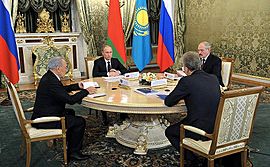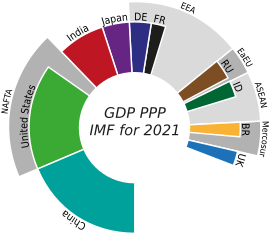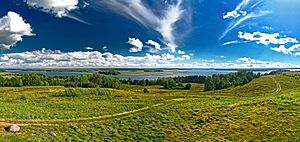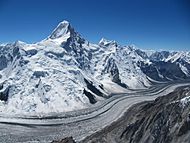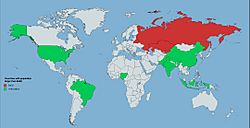Eurasian Economic Union facts for kids
- Further information: Eurasian economic integration and Common Economic Space of the Commonwealth of Independent States
Quick facts for kids
Eurasian Economic Union
(in other regional languages)
|
|||||||||||
|---|---|---|---|---|---|---|---|---|---|---|---|
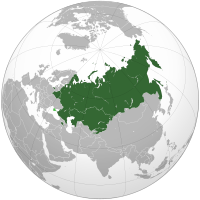
Member states Disputed territory of Crimea
|
|||||||||||
| Administrative centers | |||||||||||
| Largest city | Moscow 55°45′N 37°37′E / 55.750°N 37.617°E |
||||||||||
| Working language | Russian | ||||||||||
| Type | Economic union | ||||||||||
| Member states | |||||||||||
| Leaders | |||||||||||
|
• Chairman of the Supreme Eurasian Economic Council (2025)
|
|||||||||||
|
• Chairman of the Board of the Eurasian Economic Commission
|
|||||||||||
| Establishment | |||||||||||
|
• Original proposala
|
1994 | ||||||||||
|
• Economic Community
|
10 October 2000 | ||||||||||
|
• Eurasian Customs Union
|
1 January 2010 | ||||||||||
|
• Establishment agreed
|
18 November 2011 | ||||||||||
|
• Eurasian Economic Space
|
1 January 2012 | ||||||||||
|
• EAEU Treaty signed
|
29 May 2014 | ||||||||||
|
• EAEU established
|
1 January 2015 | ||||||||||
| Area | |||||||||||
|
• Total
|
20,229,248 km2 (7,810,556 sq mi) | ||||||||||
| Population | |||||||||||
|
• 2025 estimate
|
|||||||||||
|
• Density
|
9.16/km2 (23.7/sq mi) | ||||||||||
| GDP (PPP) | 2025 estimate | ||||||||||
|
• Total
|
|||||||||||
|
• Per capita
|
$44,888 | ||||||||||
| GDP (nominal) | 2024 estimate | ||||||||||
|
• Total
|
|||||||||||
|
• Per capita
|
$13,980 | ||||||||||
| Currency | |||||||||||
| Time zone | UTC+2 to +12 | ||||||||||
| Driving side | right | ||||||||||
| Calling code | |||||||||||
| Internet TLD | |||||||||||
The Eurasian Economic Union (EAEU or EEU) is a group of five countries in Eurasia that work together on economic matters. These countries are Armenia, Belarus, Kazakhstan, Kyrgyzstan, and Russia. They have created a single market, which means goods, services, money, and people can move freely between them.
The EAEU was officially started on January 1, 2015. The leaders of Belarus, Kazakhstan, and Russia signed the main agreement on May 29, 2014. Armenia joined on January 2, 2015, and Kyrgyzstan joined on August 6, 2015.
The main goals of the EAEU are to make it easier for countries to trade with each other. They also work together on things like transportation, energy, and foreign trade. In the future, they plan to have even closer ties, possibly even a single currency. The EAEU has special groups and courts to help it run smoothly.
History of the EAEU
How the Union Started
After the Soviet Union broke up in 1991, many countries that used to be part of it faced economic challenges. They wanted to find ways to work together again to make their economies stronger. These countries had shared a common economy, roads, and rules for a long time.
In 1991, leaders from Belarus, Kazakhstan, and Russia signed an agreement to create the Commonwealth of Independent States (CIS). This was a first step towards working together.
Working Together in the CIS
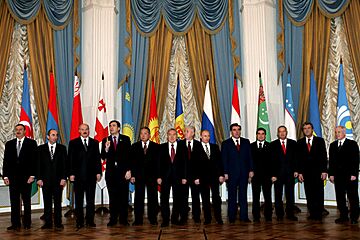
The CIS aimed to help countries cooperate on things like trade, customs, and transportation. They wanted to create a common economic area. In 1993, many CIS countries signed a treaty to form an economic union. This union would allow free movement of goods, services, money, and workers.
New Ideas for Cooperation
In 1994, the President of Kazakhstan, Nursultan Nazarbayev, suggested creating a new group called the "Eurasian Union of States." He thought the CIS wasn't doing enough. He wanted a stronger economic and political union to connect Europe and Asia. This idea was the beginning of what became the Eurasian Economic Union.
Building a Customs Union
Over the years, countries like Belarus, Kazakhstan, and Russia signed agreements to slowly build a Customs Union. A Customs Union means that countries agree not to charge taxes on goods traded between them. They also agree on the same taxes for goods coming from outside their group.
- In 1995, Belarus, Kazakhstan, and Russia signed agreements to start a Customs Union. Kyrgyzstan and Tajikistan joined later.
- In 1996, they agreed to work more closely on economic and humanitarian issues.
- In 1999, they signed a treaty to make the Customs Union and a Single Economic Space a reality.
The Eurasian Economic Community
To make economic cooperation even stronger, Belarus, Kazakhstan, Russia, Kyrgyzstan, and Tajikistan formed the Eurasian Economic Community (EurAsEC) in 2000. Uzbekistan joined in 2006. This community was like a common market, similar to the early stages of the European Union.
In 2007, Belarus, Kazakhstan, and Russia agreed to create a Customs Union among themselves. They set up a special group to manage it.
Moving Towards a Single Market
On January 1, 2010, the Customs Union of Belarus, Kazakhstan, and Russia officially began. Its main goals were to remove trade taxes between them and set common taxes for goods from other countries. This was a big step towards creating a larger single market.
Then, on January 1, 2012, these three countries created the Eurasian Economic Space. This space made sure that goods, services, money, and workers could move freely. They also set up the Eurasian Economic Commission to manage this new economic area.
Finally, on May 29, 2014, the leaders of Kazakhstan, Belarus, and Russia signed the treaty to create the Eurasian Economic Union. This union officially started on January 1, 2015. Armenia and Kyrgyzstan joined shortly after.
Who are the Members?
The Eurasian Economic Union has five full member states:
- Armenia (joined January 2, 2015)
- Belarus (joined January 1, 2015)
- Kazakhstan (joined January 1, 2015)
- Kyrgyzstan (joined August 12, 2015)
- Russia (joined January 1, 2015)
Some countries have an "observer status," which means they can attend meetings and see how the EAEU works, but they are not full members. These include:
- Cuba (since December 2020)
- Iran (since December 2024)
- Moldova (since April 2017)
- Uzbekistan (since December 2020)
Armenia joined the EAEU to get better access to a large market. Even though Armenia doesn't share a border with other EAEU members, it has agreements for goods to pass through other countries.
On February 12, 2025, Armenia's parliament approved a bill to support Armenia joining the European Union. This could mean Armenia might leave the EAEU in the future.
Who is in Charge?
Each year, one member country takes turns being the chairman of the Union. The order is alphabetical based on the Russian language. In 2025, Belarus is the chairman.
How the EAEU Works
The Eurasian Economic Union is set up to work like the European Union. It has different groups that make decisions and manage the union.
Supreme Eurasian Economic Council
This is the highest decision-making body. It includes the leaders (presidents or prime ministers) of all member countries. They approve the budget, set the main goals, and decide on the future of the EAEU.
Eurasian Economic Commission
This is the main working body of the EAEU, like a government for the union. It started in 2012 and is based in Moscow. It makes decisions on trade, economy, energy, and other important areas. It also makes sure that the rules are followed.
The Commission has two parts:
- Council: This group includes the Vice Prime Ministers from each member state. They oversee the work of the Commission and meet every three months.
- Board: This group has ten commissioners, two from each country. They manage the daily operations of the EAEU. They meet every week and help solve problems between member states.
Court of the Eurasian Economic Union
This court helps solve disagreements and explains the laws of the EAEU. It is located in Minsk, Belarus. Each member country provides two judges, who serve for nine years.
Budget and Funding
The EAEU's budget comes from contributions from its member states. In 2015, the budget was over 6.6 billion Russian roubles. Most of this money goes to the Eurasian Economic Commission and the Court. Russia also helps with extra costs for buildings and staff.
Working Language
The official working language for all EAEU bodies is Russian.
Economy of the EAEU
The EAEU aims to create a strong economic area where goods, services, money, and people can move freely. This is called the "four freedoms." These freedoms officially started on January 1, 2015.
- Free movement of goods: No customs duties or taxes on goods traded between member states.
- Free movement of capital: Money can be invested and moved easily between countries.
- Free movement of services: Businesses can offer services across the union without many restrictions.
- Free movement of people: Citizens can live, work, or study in any member state without needing special work permits.
The EAEU has a large market of about 180 million people. Its combined economy is one of the largest in the world. Since it started, trade between member states has grown.
The EAEU wants to:
- Lower prices by reducing transport costs.
- Encourage new technologies and products.
- Promote fair competition.
- Lower food prices and create more jobs.
The EAEU is also very important in the world for energy, raw materials, and farming.
-
The Moscow International Business Center in Moscow, Russia.
-
Saint Petersburg, a major city in Russia.
-
Almaty, a big city in Kazakhstan.
-
Bishkek, the capital of Kyrgyzstan.
Common Currency Ideas
Leaders have discussed creating a common currency for the EAEU, possibly called the "altyn." This would help protect their economies from global financial problems. While it's not in the current plan, some leaders believe it could happen in the future.
Energy Powerhouse
The EAEU is a major player in the world's energy market. It produces a lot of natural gas and oil, mainly because of Russia's large reserves. Kazakhstan also has significant oil and gas. Belarus gets cheaper gas from Russia. The EAEU plans to create a common electricity market and a single market for oil and gas by 2025.
Transportation and Infrastructure
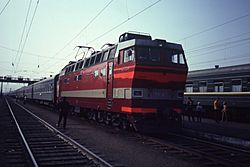
Connecting the large distances between member states is a challenge. Major cities like Moscow, Minsk, and Astana are far apart. The EAEU is working on improving roads and railways to make trade and travel easier.
Railways are especially important, as they have been the main way to transport goods across this region for a long time. The Trans-Siberian Railway is a famous example, connecting the Russian Far East to Moscow and beyond.
Farming and Food

The EAEU is a top producer of crops like sugar beet, sunflowers, rye, and barley. The Eurasian Economic Commission helps coordinate farming policies and ensures food security for the region.
Working with Other Countries
The EAEU works with many countries and groups around the world. They have signed agreements to make trade easier.
- Vietnam: The EAEU signed a free trade agreement with Vietnam in 2015.
- Iran: A free trade agreement with Iran was signed in December 2023 and became active on May 15, 2025.
- China: The EAEU and China are working together on trade and economic cooperation, especially linking with China's "Belt and Road Initiative" which aims to improve trade routes.
- Serbia: A free trade agreement with Serbia was signed in 2019.
- Singapore: Agreements on trade and economic cooperation were signed in 2019.
The EAEU is also discussing trade agreements with countries like Egypt, India, Indonesia, Israel, Mongolia, and the United Arab Emirates.
Challenges and Views
Some experts believe the EAEU has great potential for economic growth. However, others are not so sure, especially without Ukraine, which has a large economy. The European Union and the United States have also expressed concerns, seeing the EAEU as an attempt to bring former Soviet countries closer to Russia.
Despite these views, EAEU members like Kazakhstan see the union as a way to gain economic benefits and connect with growing markets in Asia.
Geography of the EAEU
The Eurasian Economic Union covers a huge area, about 15% of the world's land surface. It stretches across northern Eurasia, from the Arctic in the north to East Asia and the Middle East in the south.
- Russia and Belarus: Much of these countries are flat plains, with some mountains like the Ural Mountains. Northern Russia has cold tundra regions, while Siberia has vast taiga forests.
- Kazakhstan: This country has large steppe regions, which are flat grasslands. It also has some of the lowest points on Earth, like the Karagiye Depression.
- Armenia: This country is mostly mountainous and does not share a direct border with other EAEU members.
The EAEU has many important lakes and rivers. Lake Baikal in Russia is the world's deepest and oldest freshwater lake. Major rivers include the Volga in Europe and the Ob, Yenisey, and Lena in Siberia.
The highest point in the EAEU is Khan Tengri in Kazakhstan, a mountain that is 7,010 meters tall. The region is rich in natural resources, especially oil and natural gas, mainly in Russia and Kazakhstan.
-
Mountain range – Armenia
-
Lama River – in the Moscow region of Russia
-
Sharyn Canyon – Kazakhstan
-
On the southern shore of Issyk-Kul lake, Issyk-Kul Region – Kyrgyzstan
-
Winter – Belarus
-
A view of Mount Aragats from Aragatsotn – Armenia
-
A view of Mount Mönkh Saridag – Okinsky District, Russia
-
Lake Ayger – Armenia
-
Lake Servech – Belarus
-
Winter in the Altai Krai – Russia
-
Tian Shan mountain range – Kyrgyzstan
People of the EAEU
The total population of all EAEU member states is about 185 million people as of 2024. Most people in the EAEU live in cities. Russia and Belarus have over 70% of their populations in urban areas.
The EAEU has 22 cities with more than 1 million people, with Moscow being the largest. Siberia has the fewest inhabitants. Many different ethnic groups live within the EAEU countries.
Images for kids
-
Russian Federation - Belarus - Kazakhstan Agreement of 1995 on Customs Union in the Regional Trade Agreements Database of the World Trade Organization
-
Timeline of EAEU Integration from the World Trade Organization report
-
The Eurasian Economic Union in the Regional Trade Agreements Database of the World Trade Organization
-
The 2011 Commonwealth of Independent States Free Trade Area among Russia, Ukraine, Belarus, Uzbekistan, Moldova, Armenia, Kyrgyzstan, Kazakhstan and Tajikistan
-
Azerbaijani President Ilham Aliyev, Russian President Dmitry Medvedev and Armenian President Serzh Sargsyan hold peace talks in Moscow on November 2, 2008.
See also
 In Spanish: Unión Económica Euroasiática para niños
In Spanish: Unión Económica Euroasiática para niños
- ASEAN
- Collective Security Treaty Organization
- Comecon
- Community for Democracy and Rights of Nations
- Enlargement of the Eurasian Economic Union
- Eurasian Economic Community
- Eurasian Patent Convention
- Eurasian Patent Organisation
- Eurasianism
- Soviet Union
- New Union Treaty
- Union State
- Warsaw Pact
- List of multilateral free-trade agreements




